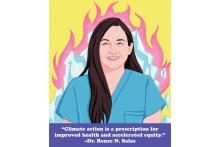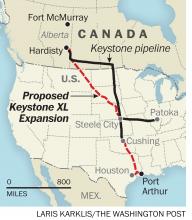climate action

MANY SCRIPTURAL METAPHORS for transformation involve variations on the “open my eyes that I may see” plea of Psalm 119; the writer of Ephesians 1, for instance, prays for the enlightenment of the “eyes of your heart” so that “you may know the hope to which he has called you.” Various authors in this issue wrestle with similar images. For example, our Prelude, which draws on the writings of French Jesuit Pierre Teilhard de Chardin, refers to the “worst failing of our minds” as the inability “to see the really big problems” that “are right under our eyes.”
Much of our culture, Zachary Lee explains in his cover feature on Hollywood “spectacle,” serves to distract us from those “really big problems” and makes it difficult for us to see in different, more hopeful ways. Bible savant Walter Brueggemann, who knows a thing or two about alternative ways of perceiving, said that prophets “are able to imagine the world other than the way that is in front of them.” But that task, that “prophetic imagination” of seeing with enlightened eyes, isn’t reserved just for prophets: It’s really an invitation to all of us who seek a better world.

Due to climate change, people — entire tribes and cultures — are losing their homes and are being displaced from their lands. Indeed, the United States military needs to be held accountable for polluting the planet. For example, if preventive measures and legislation like the Green New Deal are not enacted to curb U.S. imperialism, more Indigenous peoples will perish due to climate disasters.

FOR MANY OF us, this summer felt like a cosmic wake-up call about climate change. Fire, floods, hurricanes, and other cataclysmic signs of our rapidly heating planet seemed to offer near-apocalyptic warnings that we’re approaching a make-or-break point, especially for those already vulnerable because of poverty or geographic location. We almost didn’t need the scientists—such as those who produced the dire U.N. report in August—to once again sound the alarm, as they have done so many times over the past several decades, nature already having done the job in her impossible-to-ignore fashion.
Anger seems an apt response to global warming, given that the world’s climate crisis isn’t an unavoidable act of nature; rather, it’s rooted in intentional actions by people seeking power and wealth. The main perpetrators—including ExxonMobil and its GOP enablers—knew about the causes of climate change more than four decades ago and, as Scientific American put it, “spent millions to promote misinformation” and manipulate public opinion. Some might call such duplicity “crimes against humanity” and “indictable behavior.”

IN 2018, CLIMATE SCIENTISTS reached a consensus that, based on current global emissions, we have roughly 12 years to dramatically reverse course before we cause irreparable harm to our planet and our way of life. These and other predictions cause me to lose sleep at night, particularly when I think about the world that my two sons will inherit.
But this alarming trend is not inevitable, nor are we powerless to change course. Preventing the worst consequences and putting the planet on a zero-carbon trajectory will require a revolution of social and political will. Catalyzing this revolution will require new language, new metaphors, and new messengers.
“I can’t breathe.” These were the prophetic words said by my pastor, Rev. Howard John-Wesley, in a sermon in which he made the case that we are on the brink of ecological destruction. He preached about the thousands of species that go extinct every year. He emphasized that Americans constitute 5 percent of the world’s population but burn 25 percent of the world’s fossil fuels. These and other trends of conspicuous consumption and abuse are driving us toward global catastrophe.

SINCE MOST OF AMERICA seems to wake up most days looking for something to be outraged by, I try to keep my indignation in check. Still, the news that members of North America’s Hymn Society had chosen “Holy, Holy, Holy!” as the greatest hymn of all time—beating “Amazing Grace” in an early round by a 70-30 margin—struck me as an affront to all that is good and, well, holy. Sure, who doesn’t like singing a resonant Anglican ode to the tenets of trinitarian theology? But up against “Amazing Grace”? C’mon, now.
I’m actually a little used to this kind of hymnal-based resentment, because some years ago denominations began actually removing one of my great favorites, “Once to Every Man and Nation.” As the head of the Episcopalian hymnal committee put it, James Russell Lowell’s great poem, written at the height of the crisis over slavery, was unorthodox because “its basic premise denies the fact that God repeatedly forgives his people and gives them more than one opportunity to amend their lives.”

WHAT DO YOU see in the photo at right? Name all the objects. Spend a moment.
Hillside erosion. A semi-trailer truck with sleeper unit and maple leaf logo. Chain-link fence. Two people. U-locks at necks. Banner. Ecclesiastical stole. Heavy-grade straight chain. Clerical collar. Tree trunk. Small orange ribbon.
What is the subject of the photo? What does the camera leave out?
Photographer Murray Bush took this photo last year on May 25 on Burnaby Mountain in British Columbia. The truck is for horizontal drilling and belongs to the firm Kinder Morgan, one of the largest energy infrastructure companies in North America. The company specializes in pipelines and petroleum terminals and is the first pipeline operator to purchase a fleet of oil tankers. The fence marks a boundary—and contested space.
The two people, Laurel Dykstra and Lini Hutchings, are members of Salal + Cedar, a Christian community in Coast Salish territory. The lock-on hardware around them—the U-locks and chain—is to delay removal by the 17 Royal Canadian Mounted Police who showed up. In 2015, the Anglican Diocese of New Westminster appointed Dykstra as a sort of “priest to the Fraser River watershed.”

Juliana was in high school when she first joined Our Children’s Trust to sue the Governor of Oregon for a stable climate. During my environmental education classes, I’ve discussed the litigation to illustrate the importance of a long-term view even for an urgent planetary crisis. When my undergraduates prepare conservation workshops for local schools, they know that Juliana once sat in their places. She hopes to advocate for them in the U.S. District Courthouse in Eugene, Ore. in what may be the lawsuit of their lifetimes. And regardless of this Supreme Court’s decision, youth will gather on the courthouse steps to call for their right to a stable climate.

Within the past three months tremendous strides have been made toward protecting our earth. The People’s Climate March drew hundreds of thousands of people to the streets of New York City to advocate for climate action. The Keystone XL pipeline failed to pass the U.S. Senate. The United States and China passed a joint agreement to limit their greenhouse gas emissions.
This week there is great hope that progress will continue.
The Lima conference is seen as the last-stop in a series of slow moving international conversations leading up to the 2015 UNFCCC conference, which will happen next December in Paris. The ultimate goal of this climate-focused body of the United Nations, which has met for nearly two decades, is to have the nations of the world sign a landmark climate change agreement that drastically reduces greenhouse gas emissions country-by-country.
With Paris a year away, Lima is being called a hopeful stepping stone in this process.

As the Intergovernmental Panel on Climate Change (IPCC) releases a groundbreaking and comprehensive report detailing the impacts of climate change as “severe, pervasive, and irreversible,” young evangelicals across the United States are coming together to pray for urgent and responsible climate action to protect life and defend their future. Organized by the Young Evangelicals for Climate Action, the Evangelical Environmental Network, and Renewal: Students Caring for Creation, prayer events are being held across the Nation — and on more than 20 Christian campuses — in recognition of April 3 as the 2014 National Day of Prayer for Climate Action.
While evangelicals are not typically associated with climate action, YECA spokesperson Ben Lowe points out,“Climate disruption is not just a scientific or political issue — it’s first and foremost a moral issue and biblical issue … It’s about protecting life and, as evangelicals, we’re particularly concerned about the ways our pollution and political inaction is affecting the poor and those who are most vulnerable.”
Communities around the world are already experiencing the negative impacts of climate change. The new IPCC reports details how the poorest countries are being seriously affected by climate change, with severe consequences to global food security, human health, and economic development. The poor will not be the only ones influenced by climate change, as IPCC Chairman Rajendra Pachauri says, "Nobody on this planet is going to be untouched by the impacts of climate change.”

The day after the Washington Post announced it was moving its top environmental reporter off the green beat to cover politics at the White House, this op-ed went up toeing an uncomfortably familiar line: by speaking out against the Keystone XL pipeline, environmentalists are “missing the climate-endangered forest for the trees.”
Leaving aside for a moment the uncomfortable irony of being reprimanded for missing the big fight by an outlet that is reshuffling focus on that very front: the editorial board, respectfully, is wrong. Not that it doesn’t have a point, but that point is concrete and incremental – and misses the entire meaning of the forest of protests over the last 18 months.

Last week, the State Department issued its next draft of the supplemental environmental impact statement (SEIS) assessing the northern route of TransCanada’s Keystone XL pipeline. Officially, the State Department does not make any recommendations on whether the pipeline should be approved or denied. But the summation language is all to the positive — making it clear that the State Department still doesn’t understand global warming and its disastrous consequences.
I’m sure the scientists, policy analysts, and environmentalists among us will soon sort out and explain the hundreds of pages released by the State Department March 1. But until then, here’s the part I found most significant: “The life-cycle carbon footprint, for transportation fuels produced in U.S. refineries, would increase if the project were approved.”
Please note that this information is buried way way way deep in the documents. The general summary by the State Department is favorable toward industry and the pipeline, though there are some conclusions drawn that I think are not supportable.

In my last column, "Three Numbers that Predict the Future of the Planet", I wrote about the state of the climate crisis and focused on three key data points that reveal a bleak, though not altogether hopeless, reality for us and for the rest of the planet.
As promised, this column is forward-looking and moves from describing the problem to prescribing the solution. To this end, I continue to draw heavily from the wisdom of Bill McKibben, Jim Ball, and other climate prophets who understand the times and are faithfully fighting to get us on the right track.
The way forward is not easy, but it will be good in the long run. Essentially, we need to set and enforce a limit on all remaining global warming pollution on the national and international scale, which will, we hope, keep warming to within 2oC. This will include some sort of pricing mechanism so that polluters have to take responsibility for paying for the costs of their own pollution. The problem is that we have not yet been able to muster the socio-political momentum necessary to reach these binding agreements. Turns out the polluters (largely the fossil fuel industry) don’t want to have to clean up after themselves. They’re also willing to fight with billions of dollars in campaign contributions and lobbying money to keep the status quo.

Good news: Evangelical Christians are stepping back up to overcome the climate crisis.
After months of careful preparation, a new national advocacy initiative called Young Evangelicals for Climate Action (Y.E.C.A.) has just gone live.
In seeking to live as Christ’s disciples, Y.E.C.A. has come to see the climate crisis not only as a pressing challenge to justice and freedom, but also as a profound threat to “the least of these” with whom Jesus identifies in Matthew 25. The early effects of climate change are already impacting many of our neighbors, both in the U.S. and around the world, and our time to act is running short.